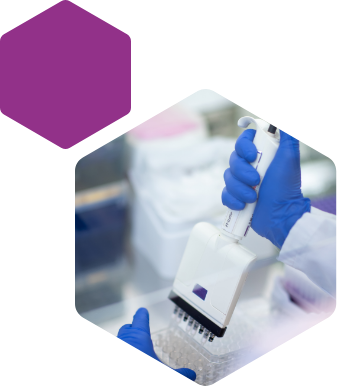Our services for Permeability and Transporters research
To be able to produce the aimed therapeutical effect, the drug needs to reach its target. In vitro permeability assays are used to evaluate the capability of potential drug molecules to permeate across epithelial and endothelial barriers of the body.
There are number of membrane transporters, which are involved in drug absorption, distribution, and elimination. Therefore, evaluation of transporter-mediated drug-drug interactions is required by the regulatory authorities to evaluate whether the compound is a substrate or an inhibitor of various transporters.
As part of our early ADME services, series of compounds can be rapidly screened with the Parallel Artificial Membrane Permeability Assay (PAMPA). The assay provides information about passive, transcellular permeability through a gastrointestinal tract lipid formulation.

In vitro permeability assays with Caco-2 or MDCK(-MDR1/BCRP) cell lines are used for evaluating both passive and active transport of drugs to blood circulation across the intestinal membranes. The Caco-2 is most often used for evaluating overall permeability and involvement of efflux-transporters or active uptake in a bidirectional experiment.
The MDCK-cells are a convenient tool for assessment of efflux transporters MDR1 and BCRP (and their inhibition) as cell lines overexpressing these transporters are available.
Several assays are also available for studies with individual uptake transporters to investigate whether the new drug candidate is a substrate (potential DDI victim), or an inhibitor (potential DDI perpetrator) towards drug transporters.
Parallel Artificial Membrane Permeability Assay (PAMPA)
- High-through put assay
- Evaluation of passive permeation
As a high-throughput screening permeability assay, we offer the Parallel Artificial Membrane Permeability Assay (PAMPA). This assay is used as an in vitro model for passive, transcellular permeation. It is a fast and easy method which determines the permeability of test compounds from a donor compartment, through a lipid-infused artificial membrane into an acceptor compartment. PAMPA studies are performed using the PAMPA explorer kit (pION Inc) and the double sink protocol.
Caco-2 / MDCK Permeability
- Bi-directional Caco-2 / MDCK transport to screen for permeability and involvement of active transport
- Evaluation of gut wall permeability
The use of Caco-2 cells (human colon carcinoma cell line) has become the industry standard for investigation of permeation, as these cells endogenously express a variety of transporter proteins that are present in various endothelial and epithelial barriers of the body. In addition to Caco-2, we also provide MDCK (Madin Darby canine kidney cell line) assays for investigating permeation.
Caco-2 and MDCK assays are available as mono- and bidirectional, and in the presence or absence of pH gradient across the cell monolayer. These experiments are intended for evaluation of epithelial and endothelial permeability, intestinal absorption, and involvement of active transport. As a further investigation, the efflux or uptake transporter(s) involved can be identified using chemical transporter inhibitors and/or transporter specific in vitro models.
In vitro permeability assessment for BCS classification
The Biopharmaceutics Classification System (BCS) provides a robust framework for categorizing compounds based on their in vitro solubility and permeability, enabling accurate prediction of oral drug absorption in vivo and supporting formulation strategies.
To facilitate BCS classification, we offer Caco-2 permeability assessments, which are fully aligned with the ICH M9 guidance. This assay has been rigorously validated using a set of control compounds that represent diverse permeability characteristics.
The ICH M9 guidance aims to streamline drug development by allowing biopharmaceutics classification of system-based biowaivers, reducing the need for in vivo bioequivalence studies. Such waivers apply to certain orally administered systemic dosage forms if the compound qualifies as BCS Class I (high solubility, high permeability) or Class III (high solubility, low permeability). If you are working on a compound that you plan to apply for a biowaiver, we can assist with solubility and in vitro dissolution studies within the Symeres family.
For more information, contact our team!
Efflux Transporters
- Differentiated MDCKII cell monolayers expressing selected drug transporter for substrate and inhibition assays
- Vesicular transport assays for efflux transporter inhibition

A family of ATP binding cassette (ABC) transporters is an important group of membrane transporters involved in drug absorption, distribution and elimination. Regulatory authorities (EMA, FDA) recommend investigating the potential roles of ABC superfamily members ABCB1 (MDR1, P-glycoprotein), and ABCG2 (BCRP) for transporter-mediated drug-drug interactions (DDI), by evaluating whether the new drug candidate is a substrate (potential DDI victim) or an inhibitor (potential DDI perpetrator) towards drug transporters. Additionally, evaluation of inhibition towards bile salt export pump (BSEP, ABCB11) is recommended due to safety concerns associated with inhibition of this transporter.
In substrate assays the permeability of the test compound is measured through human efflux transporter expressing MDCKII cell monolayers to both directions in the presence and absence of chemical transporter inhibitor. Active transport is observed as higher apparent permeability in basolateral to apical than in apical to basolateral direction and confirmed by reduction of efflux ratio by a known chemical inhibitor and/or by a smaller efflux ratio with control cells lacking the transfected human transporter. Similarly, in the inhibition assay the impact of the test compound on active transport of a probe substrate is evaluated. Assays are conducted with ready-to-use transfected MDCKII monolayers and LC/MS/MS is used as an analytical tool.
Inhibition of transporters P-gp, BCRP and BSEP can also be studied with inside-out membrane vesicles prepared from mammalian cells expressing a single human efflux transporter. The inhibition is evaluated by measuring ATP dependent vesicular uptake of a probe substrate into membrane vesicles in the presence and absence of test compound using LC/MS/MS for analysis.
Uptake Transporters
- Substrate and inhibition assays
- Using human embryonic kidney (HEK293) cells transiently transfected with a single human transporter
A family of solute carriers (SLC) is an important group of membrane transporters involved in drug absorption, distribution and elimination. Regulatory authorities (EMA, FDA) recommend investigating the potential roles of SLC superfamily members OATP1B1, OATP1B3, OAT1, OAT3, OCT2, MATE1 and MATE2 for transporter-mediated drug-drug interactions (DDI), by evaluating whether the new drug candidate is a substrate (potential DDI victim) or an inhibitor (potential DDI perpetrator) towards drug transporters. In addition, EMA suggests also considering investigation of OCT1, whenever in vitro and in vivo findings suggest its involvement in DDI to be anticipated.

In substrate assays the active uptake of the test compound into cells is measured directly, while transporter inhibition is evaluated by measuring the cellular uptake of a probe substrate into cells in the presence and absence of the test compound. Both assays can be tailored for screening using 1-2 concentrations or to fulfill regulatory guidelines using a more comprehensive study set-up. Assays are conducted with human embryonic kidney (HEK293) cells transiently transfected with a single human transporter and LC/MS/MS is used as an analytical tool.
